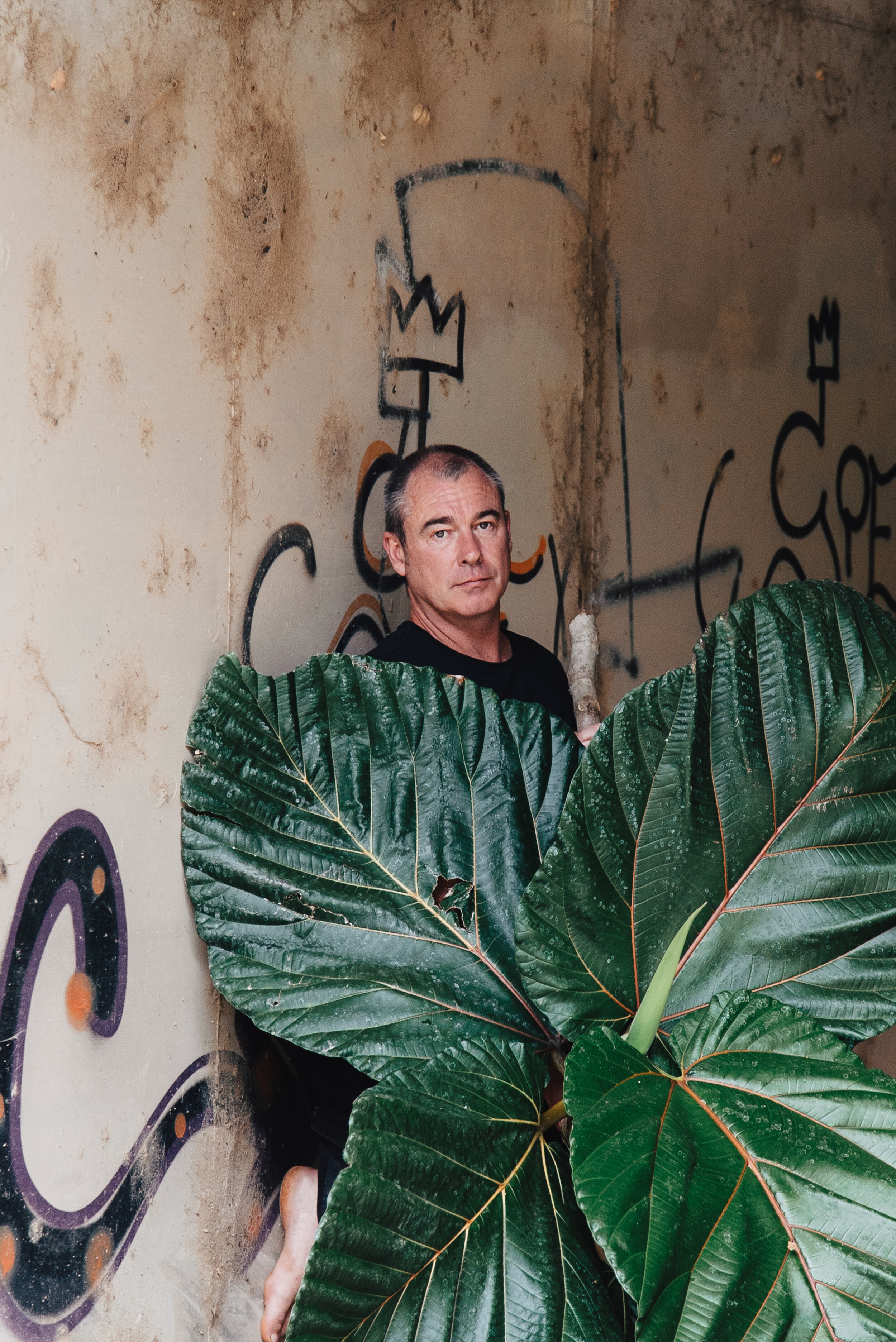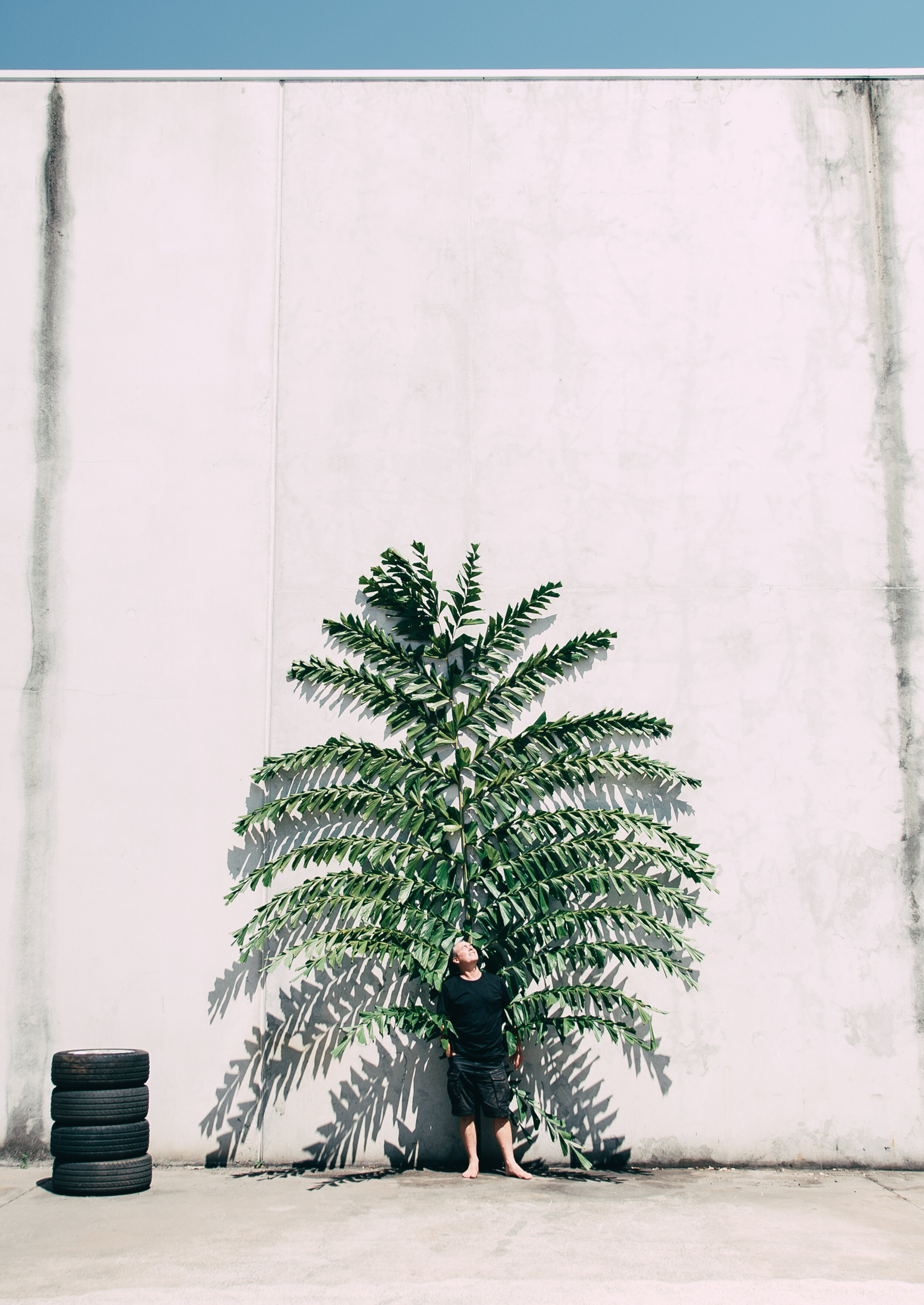Big Leaf Man
Jony Taylor is in the business of growing big leaves. Having spent a chunk of his professional career creating botanical installations for the likes of Elton John and the Rolling Stones in London, finding a home in the The Northern Rivers may seem like an unlikely plot-twist to his story. But after seeing his farm in Burringbar – a cultivated expanse of lush, prehistoric foliage – we couldn’t imagine him anywhere else. Interview by Sasha Rose.
Photography by:
Ben Douglas @bcmd.photo
Anna Hutchcroft @annahutch_photo
We stand beside a Ficus dammaropsis, a tropical fig tree native to New Guinea where its name in Tok Pisin is kapiak. After searching for a year, Jony was able to locate and order five seedlings. On the day of the delivery, there were the 100 palms he ordered, but the Ficus dammaropsis had been stolen. Eventually, the seller sent him three replacements. He planted the trees for his mum because of how rare and beautiful they are. He tells me about how on the day of his highschool exams, his mum, instead of taking him to school, took him to Spain for a weeklong holiday. Calling his dad from the airport to let him know, she said that Jony could do his exams later. It was only after her death, upon returning to her home in Belfast after travelling for months, that Jony found a book in his mother’s library about Kenneth Turner’s floristry.
Photo by Ben Douglas
Photo by Ben Douglas.
Photo by Anna Hutchcroft.
Photo by Anna Hutchcroft.
Photo by Anna Hutchcroft.
We stand beside a Ficus dammaropsis, a tropical fig tree native to New Guinea where its name in Tok Pisin is kapiak. After searching for a year, Jony was able to locate and order five seedlings. On the day of the delivery, there were the 100 palms he ordered, but the Ficus dammaropsis had been stolen. Eventually, the seller sent him three replacements. He planted the trees for his mum because of how rare and beautiful they are. He tells me about how on the day of his highschool exams, his mum, instead of taking him to school, took him to Spain for a weeklong holiday. Calling his dad from the airport to let him know, she said that Jony could do his exams later. It was only after her death, upon returning to her home in Belfast after travelling for months, that Jony found a book in his mother’s library about Kenneth Turner’s floristry.
After reading the book, he moved from Belfast –where, growing up, the nighttime streets were filled with cars on fire and glass bottles flying through the air – to London, where he lived alone in a four-bedroom flat above Kenneth Turner’s florist in Mayfair. He told me about setting up a church in the city for The Rolling Stones for a party they were throwing “making it chaotic and beautiful with hectic flowers, orchids and other wild stuff.” He told me about weekly flower installations at Elton John’s house, flowers for Sting and later, flowers for gay bars all around inner-Sydney. The flamboyance and playfulness that came with those jobs allowed for deep learning about flowers and experimentation with colours and form and scale.
When he was about eight-years-old, Jony liked to wear a long black cloak and his bedroom was all black and filled with 40 glass tanks and their cold-blooded inhabitants. In Belfast, he was the head of the reptile department at his local pet shop. Each week he would go outside, collect foliage and other things from the garden and rearrange new landscapes for his pets. Although still employing his creativity to work with botanical elements, his focus has pivoted towards cultivating, growing, arranging and installing flowers and leaves. His process is considered and slow. First he has to think about what the leaves will be like at the time of installation – if in two months they will be yellow, or burnt from no rain. Then, he visits the space and spends time drawing different designs. The night before the installation he gets no sleep, counting down the hours until it’s time to load the truck with his wife Jo. Together they might gently place some six metre-long leaves in the delivery truck, cushioning them with blankets and cardboard, and drive carefully slowly up their steep driveway so as not to damage them.
I asked Jony if he had heard of a poem called Les Etiquettes Jaunes by Frank O’Hara, about a big leaf that is picked up from the sidewalk and admired. He said he hadn’t and so I read it to him. The poem is kind of funny and when I finished it we both laughed. Jony said the poem was mad and that he liked it. My friend who initially showed me the poem wrote something recently. He had been looking at autumn leaves, thinking about the evolutionary function of beauty – wondering what it is about decaying leaves that is beautiful to him, or if there was any biological purpose to the feeling he got when he looked at the reds and yellows of turning leaves. I asked Jony what it is he likes about the big leaves and he said he wasn’t sure exactly, but most probably their grandness. He said when he looks at them he is amazed at their brilliance.
We sat beside a little dam with lily pads, flanked at the far side by Licuala peltata sumawongii, the water a bluey-green lustre. I asked Jony why it looked like that and he said the water was just always that crazy, beautiful colour and he could not explain it any further. I am reminded of Maggie Nelson’s Bluets. She writes about an object’s capacity to emit, reflect, absorb, transmit light and how that interacts with an object’s various surfaces, elasticity, volumes, degrees of solidity and how that interacts with our perception. Fifteen days after humans are born, eyes begin to discern colour within what is essentially a shimmering mass of light. But when Nelson asks a biologist, who is an expert in guppy menopause, why it is that a male guppy looking for a mate is orange, the scientist responds simply “in the face of some questions, biologists can only vacate the field.”
In a story that is vaguely reminiscent of Noah and his Ark: in an effort to preserve rare and beautiful palms and plants – after Crystal Creek froze over and all his agaves and succulents got burned and two major floods – one, where in the space of an hour, eight months of work rushed past him – Jony now lives on the side of a mountain in upper Burringbar. There are waterfalls across the ridge deeper into the forest and sometimes there are landslides, but water (if it flows) can run wild and strong without destroying his symbiotic and scattered planting. In a journal, he wrote “Valley of the Giants” and spent a year researching and thinking about how and what he would like to plant.
It is a balance of extremes. There are soft leaves the colour of radioactive waste called ‘lime zingers’ and small shrub-sized bromeliads with red flowers. There are hundreds of palms, some with single leaves as tall as trees and others with leaves wide as Range Rovers. There are small things and rare things, a plant with a stem up to my hip with a layered, oval-shaped flower he calls a green grenade and native ginger with green and blue marble-sized seed pods. Right next to these plants is one of Jony’s favourite palms, a marojejya darianii – native to Madagascar and considered critically endangered – and we have to turn our necks all the way up just to see the entire length of one leaf.
Jony is the creative director of Big Leaf Boutique. Specialising in tropical botanical installations for weddings and events, their family farm in Burringbar supplies all of the foliage for their work.





